Analysis of Maternal Health, Barriers, and Interventions in India
VerifiedAdded on 2020/04/07
|15
|3357
|141
Report
AI Summary
This report provides a comprehensive overview of maternal health in India, addressing the significant challenges and issues faced by expecting mothers. It begins with an executive summary highlighting the global concern surrounding maternal mortality and the importance of maternal health for future generations. The report delves into the current maternal mortality rate in India, supported by statistical data, and identifies key barriers to maternal health, including poverty, lack of healthcare infrastructure, child marriage, adolescent pregnancy, lack of awareness, domestic violence, malnutrition, and communicable diseases. It examines the different aspects of care a woman needs during pregnancy and critically analyzes the Millennium Development Goals (MDGs) and Sustainable Development Goals (SDGs) related to maternal health in India. Furthermore, the report discusses the various interventions and solutions required to reduce maternal mortality, emphasizing the importance of antenatal, intranatal, and postnatal services, safe deliveries, availability of life-saving medicines, and emergency care facilities, and concludes with recommendations for improving maternal health outcomes in India.
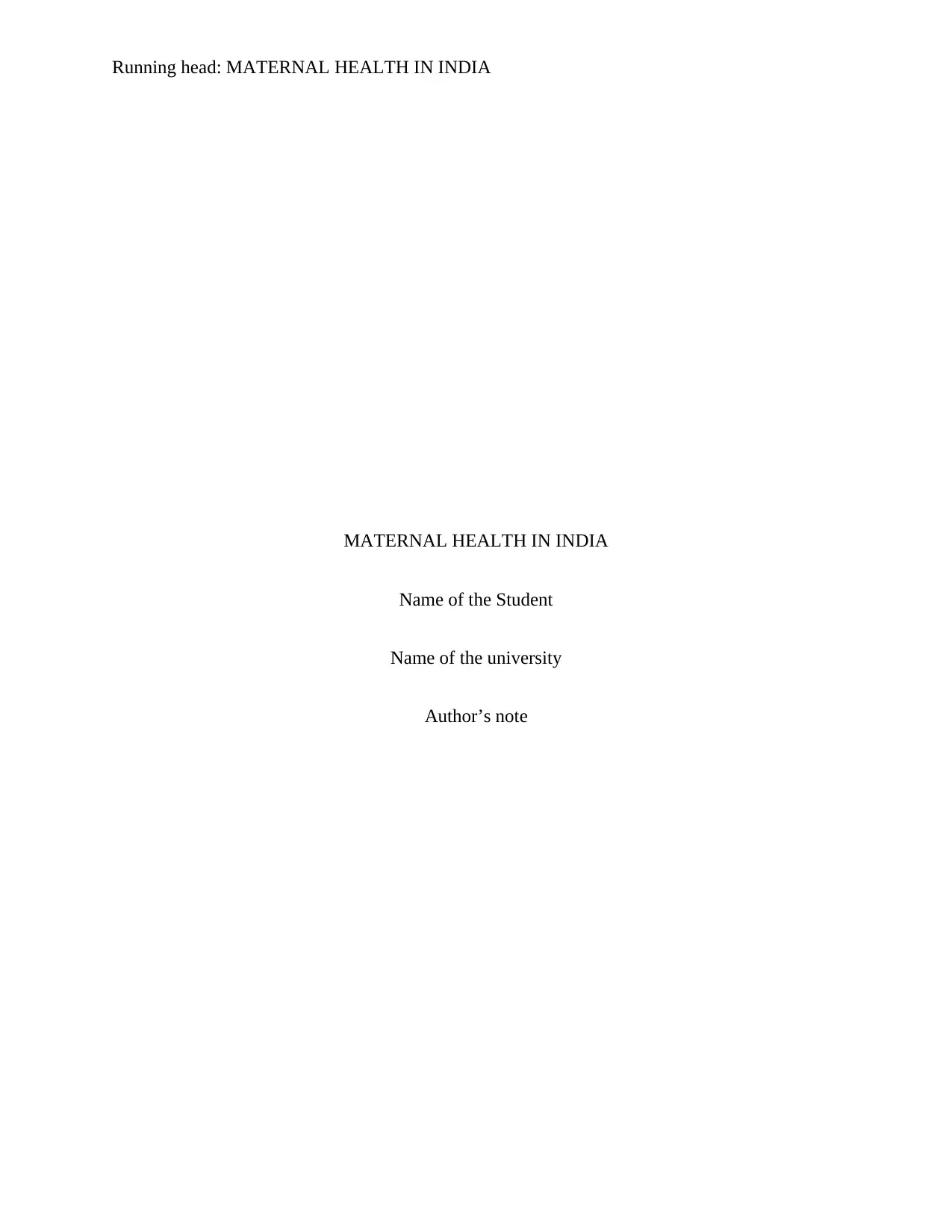
Running head: MATERNAL HEALTH IN INDIA
MATERNAL HEALTH IN INDIA
Name of the Student
Name of the university
Author’s note
MATERNAL HEALTH IN INDIA
Name of the Student
Name of the university
Author’s note
Paraphrase This Document
Need a fresh take? Get an instant paraphrase of this document with our AI Paraphraser
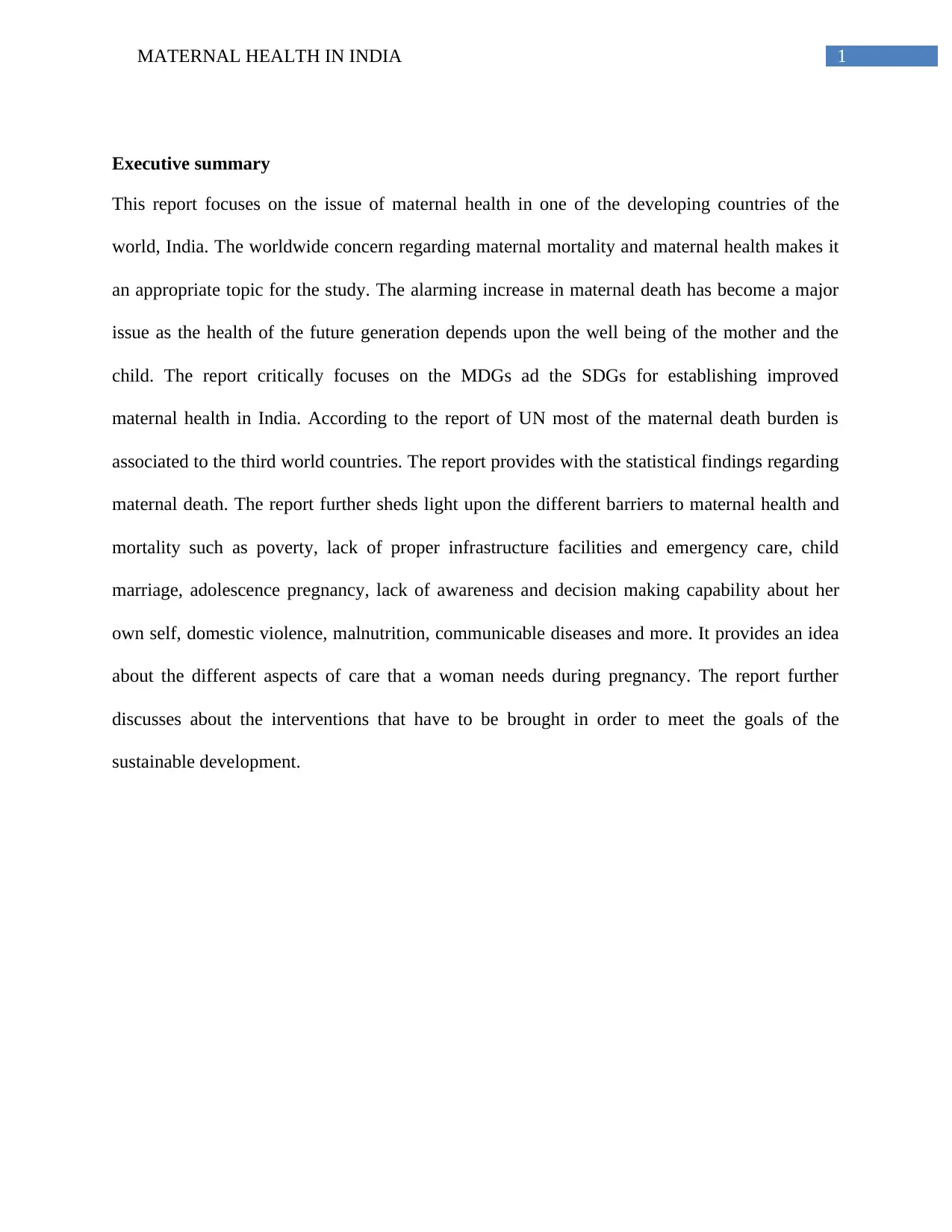
1MATERNAL HEALTH IN INDIA
Executive summary
This report focuses on the issue of maternal health in one of the developing countries of the
world, India. The worldwide concern regarding maternal mortality and maternal health makes it
an appropriate topic for the study. The alarming increase in maternal death has become a major
issue as the health of the future generation depends upon the well being of the mother and the
child. The report critically focuses on the MDGs ad the SDGs for establishing improved
maternal health in India. According to the report of UN most of the maternal death burden is
associated to the third world countries. The report provides with the statistical findings regarding
maternal death. The report further sheds light upon the different barriers to maternal health and
mortality such as poverty, lack of proper infrastructure facilities and emergency care, child
marriage, adolescence pregnancy, lack of awareness and decision making capability about her
own self, domestic violence, malnutrition, communicable diseases and more. It provides an idea
about the different aspects of care that a woman needs during pregnancy. The report further
discusses about the interventions that have to be brought in order to meet the goals of the
sustainable development.
Executive summary
This report focuses on the issue of maternal health in one of the developing countries of the
world, India. The worldwide concern regarding maternal mortality and maternal health makes it
an appropriate topic for the study. The alarming increase in maternal death has become a major
issue as the health of the future generation depends upon the well being of the mother and the
child. The report critically focuses on the MDGs ad the SDGs for establishing improved
maternal health in India. According to the report of UN most of the maternal death burden is
associated to the third world countries. The report provides with the statistical findings regarding
maternal death. The report further sheds light upon the different barriers to maternal health and
mortality such as poverty, lack of proper infrastructure facilities and emergency care, child
marriage, adolescence pregnancy, lack of awareness and decision making capability about her
own self, domestic violence, malnutrition, communicable diseases and more. It provides an idea
about the different aspects of care that a woman needs during pregnancy. The report further
discusses about the interventions that have to be brought in order to meet the goals of the
sustainable development.
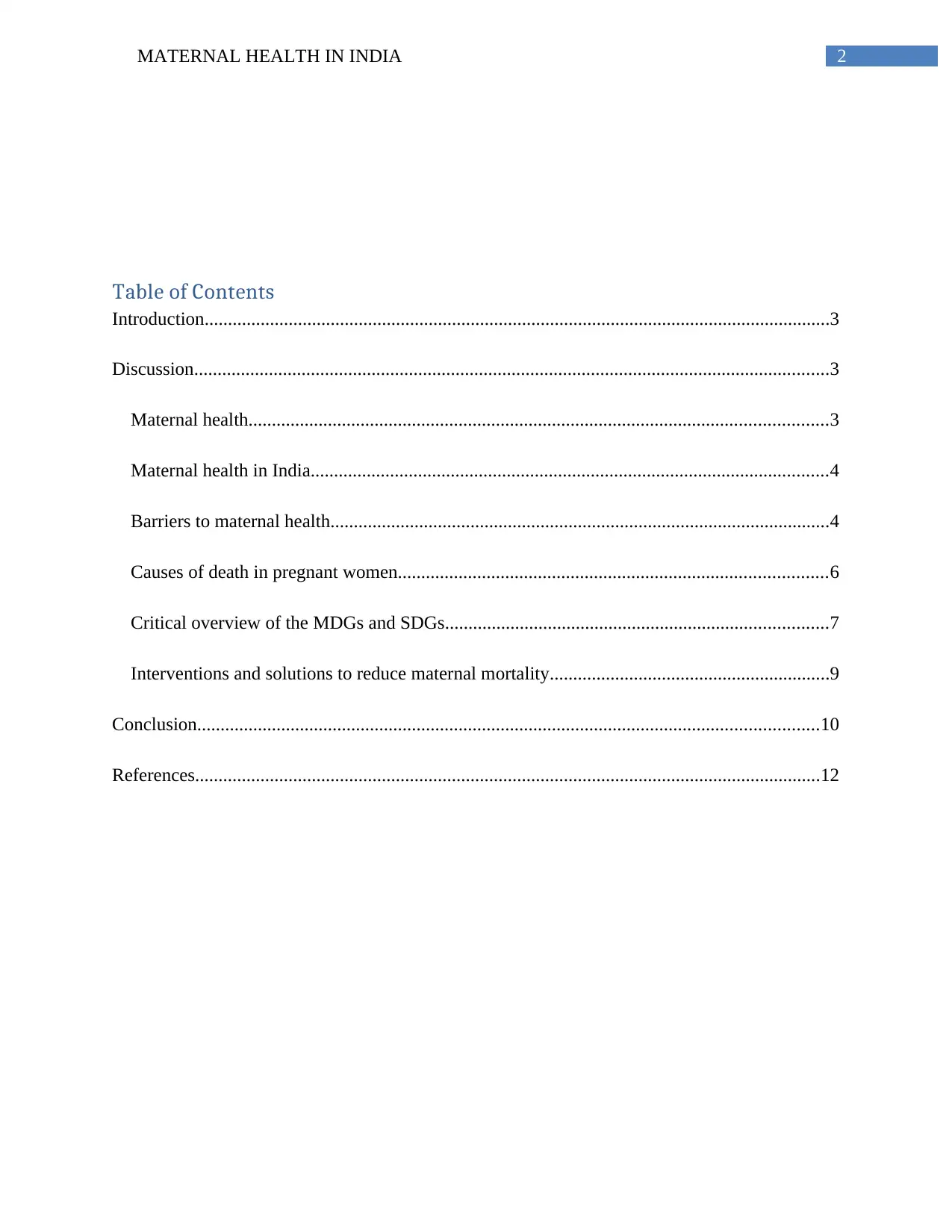
2MATERNAL HEALTH IN INDIA
Table of Contents
Introduction......................................................................................................................................3
Discussion........................................................................................................................................3
Maternal health............................................................................................................................3
Maternal health in India...............................................................................................................4
Barriers to maternal health...........................................................................................................4
Causes of death in pregnant women............................................................................................6
Critical overview of the MDGs and SDGs..................................................................................7
Interventions and solutions to reduce maternal mortality............................................................9
Conclusion.....................................................................................................................................10
References......................................................................................................................................12
Table of Contents
Introduction......................................................................................................................................3
Discussion........................................................................................................................................3
Maternal health............................................................................................................................3
Maternal health in India...............................................................................................................4
Barriers to maternal health...........................................................................................................4
Causes of death in pregnant women............................................................................................6
Critical overview of the MDGs and SDGs..................................................................................7
Interventions and solutions to reduce maternal mortality............................................................9
Conclusion.....................................................................................................................................10
References......................................................................................................................................12
⊘ This is a preview!⊘
Do you want full access?
Subscribe today to unlock all pages.

Trusted by 1+ million students worldwide
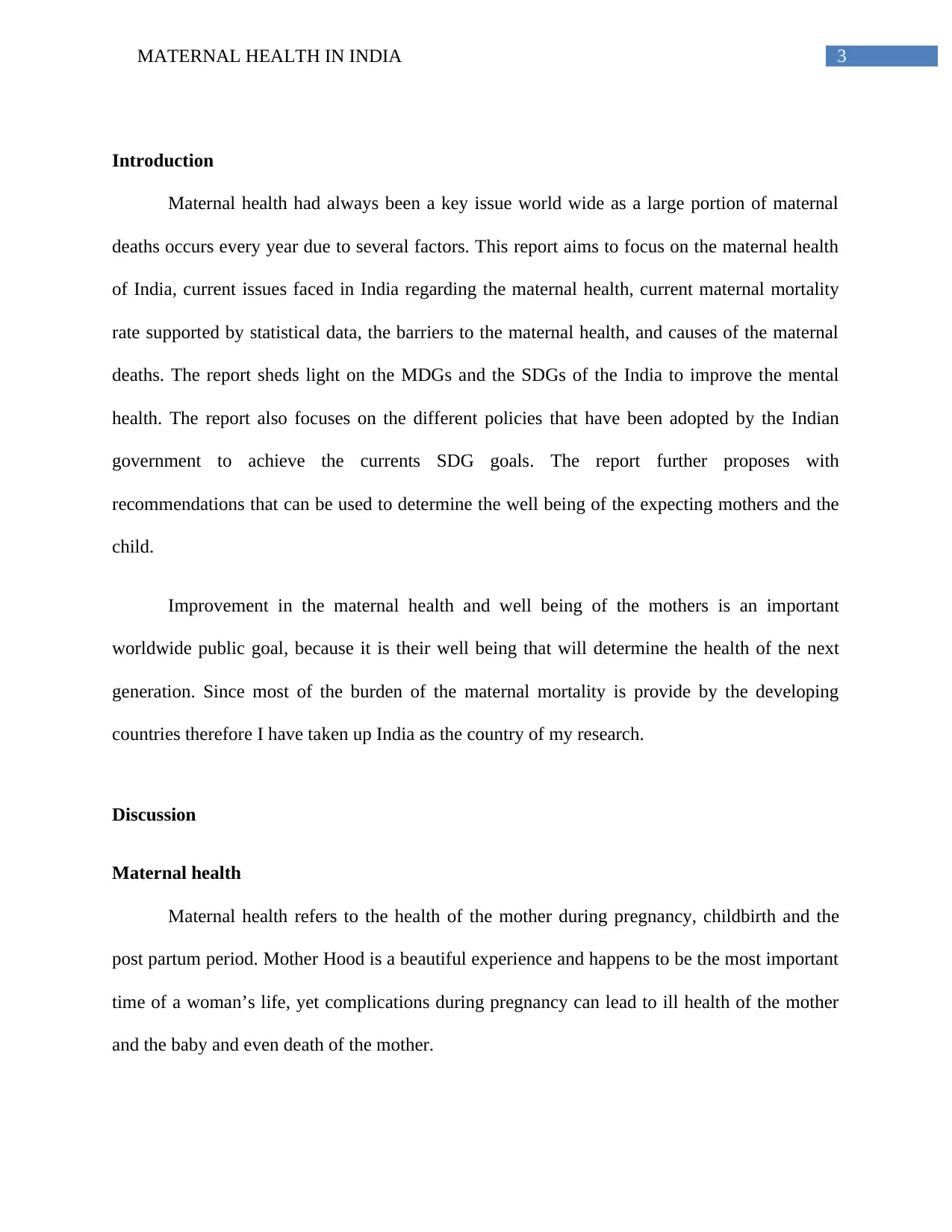
3MATERNAL HEALTH IN INDIA
Introduction
Maternal health had always been a key issue world wide as a large portion of maternal
deaths occurs every year due to several factors. This report aims to focus on the maternal health
of India, current issues faced in India regarding the maternal health, current maternal mortality
rate supported by statistical data, the barriers to the maternal health, and causes of the maternal
deaths. The report sheds light on the MDGs and the SDGs of the India to improve the mental
health. The report also focuses on the different policies that have been adopted by the Indian
government to achieve the currents SDG goals. The report further proposes with
recommendations that can be used to determine the well being of the expecting mothers and the
child.
Improvement in the maternal health and well being of the mothers is an important
worldwide public goal, because it is their well being that will determine the health of the next
generation. Since most of the burden of the maternal mortality is provide by the developing
countries therefore I have taken up India as the country of my research.
Discussion
Maternal health
Maternal health refers to the health of the mother during pregnancy, childbirth and the
post partum period. Mother Hood is a beautiful experience and happens to be the most important
time of a woman’s life, yet complications during pregnancy can lead to ill health of the mother
and the baby and even death of the mother.
Introduction
Maternal health had always been a key issue world wide as a large portion of maternal
deaths occurs every year due to several factors. This report aims to focus on the maternal health
of India, current issues faced in India regarding the maternal health, current maternal mortality
rate supported by statistical data, the barriers to the maternal health, and causes of the maternal
deaths. The report sheds light on the MDGs and the SDGs of the India to improve the mental
health. The report also focuses on the different policies that have been adopted by the Indian
government to achieve the currents SDG goals. The report further proposes with
recommendations that can be used to determine the well being of the expecting mothers and the
child.
Improvement in the maternal health and well being of the mothers is an important
worldwide public goal, because it is their well being that will determine the health of the next
generation. Since most of the burden of the maternal mortality is provide by the developing
countries therefore I have taken up India as the country of my research.
Discussion
Maternal health
Maternal health refers to the health of the mother during pregnancy, childbirth and the
post partum period. Mother Hood is a beautiful experience and happens to be the most important
time of a woman’s life, yet complications during pregnancy can lead to ill health of the mother
and the baby and even death of the mother.
Paraphrase This Document
Need a fresh take? Get an instant paraphrase of this document with our AI Paraphraser
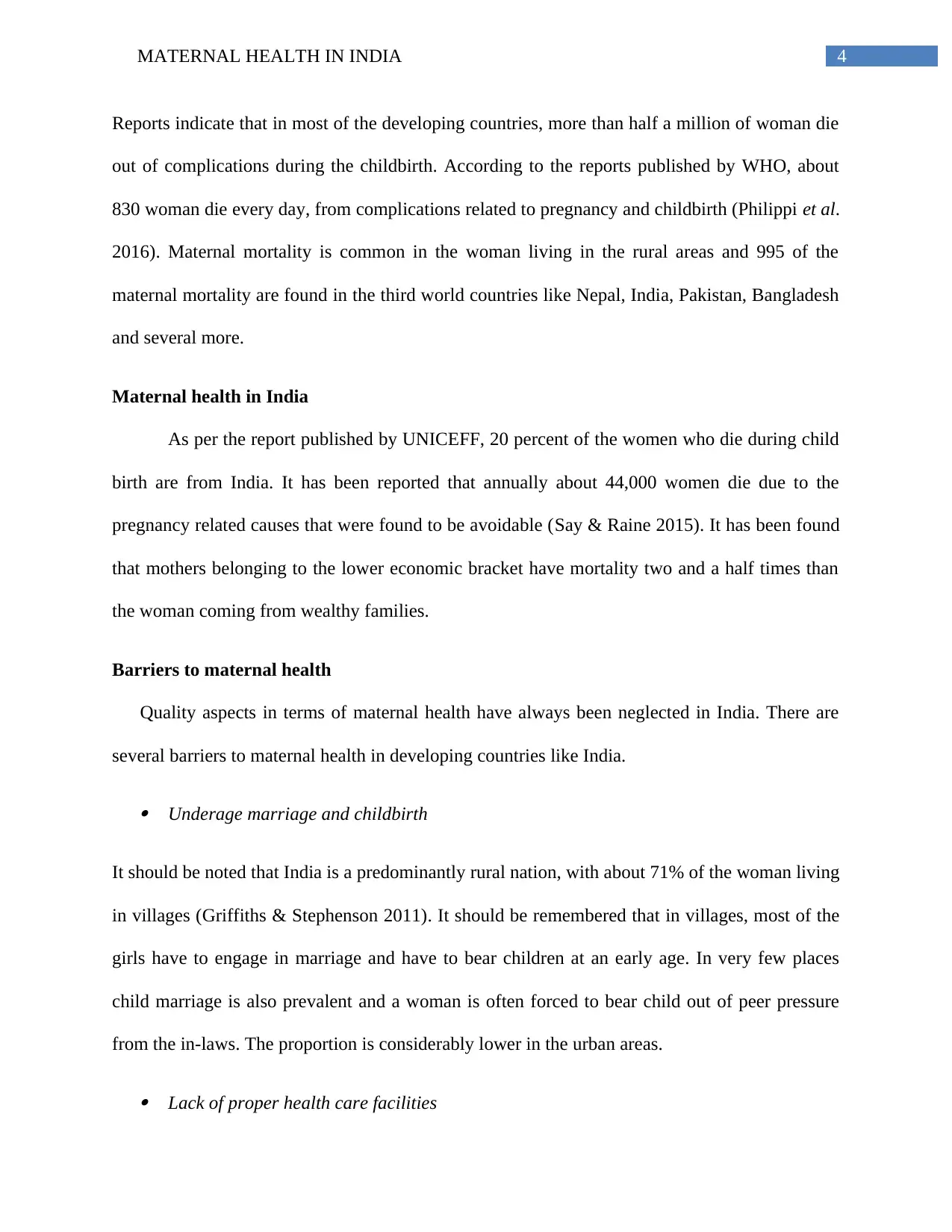
4MATERNAL HEALTH IN INDIA
Reports indicate that in most of the developing countries, more than half a million of woman die
out of complications during the childbirth. According to the reports published by WHO, about
830 woman die every day, from complications related to pregnancy and childbirth (Philippi et al.
2016). Maternal mortality is common in the woman living in the rural areas and 995 of the
maternal mortality are found in the third world countries like Nepal, India, Pakistan, Bangladesh
and several more.
Maternal health in India
As per the report published by UNICEFF, 20 percent of the women who die during child
birth are from India. It has been reported that annually about 44,000 women die due to the
pregnancy related causes that were found to be avoidable (Say & Raine 2015). It has been found
that mothers belonging to the lower economic bracket have mortality two and a half times than
the woman coming from wealthy families.
Barriers to maternal health
Quality aspects in terms of maternal health have always been neglected in India. There are
several barriers to maternal health in developing countries like India.
Underage marriage and childbirth
It should be noted that India is a predominantly rural nation, with about 71% of the woman living
in villages (Griffiths & Stephenson 2011). It should be remembered that in villages, most of the
girls have to engage in marriage and have to bear children at an early age. In very few places
child marriage is also prevalent and a woman is often forced to bear child out of peer pressure
from the in-laws. The proportion is considerably lower in the urban areas.
Lack of proper health care facilities
Reports indicate that in most of the developing countries, more than half a million of woman die
out of complications during the childbirth. According to the reports published by WHO, about
830 woman die every day, from complications related to pregnancy and childbirth (Philippi et al.
2016). Maternal mortality is common in the woman living in the rural areas and 995 of the
maternal mortality are found in the third world countries like Nepal, India, Pakistan, Bangladesh
and several more.
Maternal health in India
As per the report published by UNICEFF, 20 percent of the women who die during child
birth are from India. It has been reported that annually about 44,000 women die due to the
pregnancy related causes that were found to be avoidable (Say & Raine 2015). It has been found
that mothers belonging to the lower economic bracket have mortality two and a half times than
the woman coming from wealthy families.
Barriers to maternal health
Quality aspects in terms of maternal health have always been neglected in India. There are
several barriers to maternal health in developing countries like India.
Underage marriage and childbirth
It should be noted that India is a predominantly rural nation, with about 71% of the woman living
in villages (Griffiths & Stephenson 2011). It should be remembered that in villages, most of the
girls have to engage in marriage and have to bear children at an early age. In very few places
child marriage is also prevalent and a woman is often forced to bear child out of peer pressure
from the in-laws. The proportion is considerably lower in the urban areas.
Lack of proper health care facilities
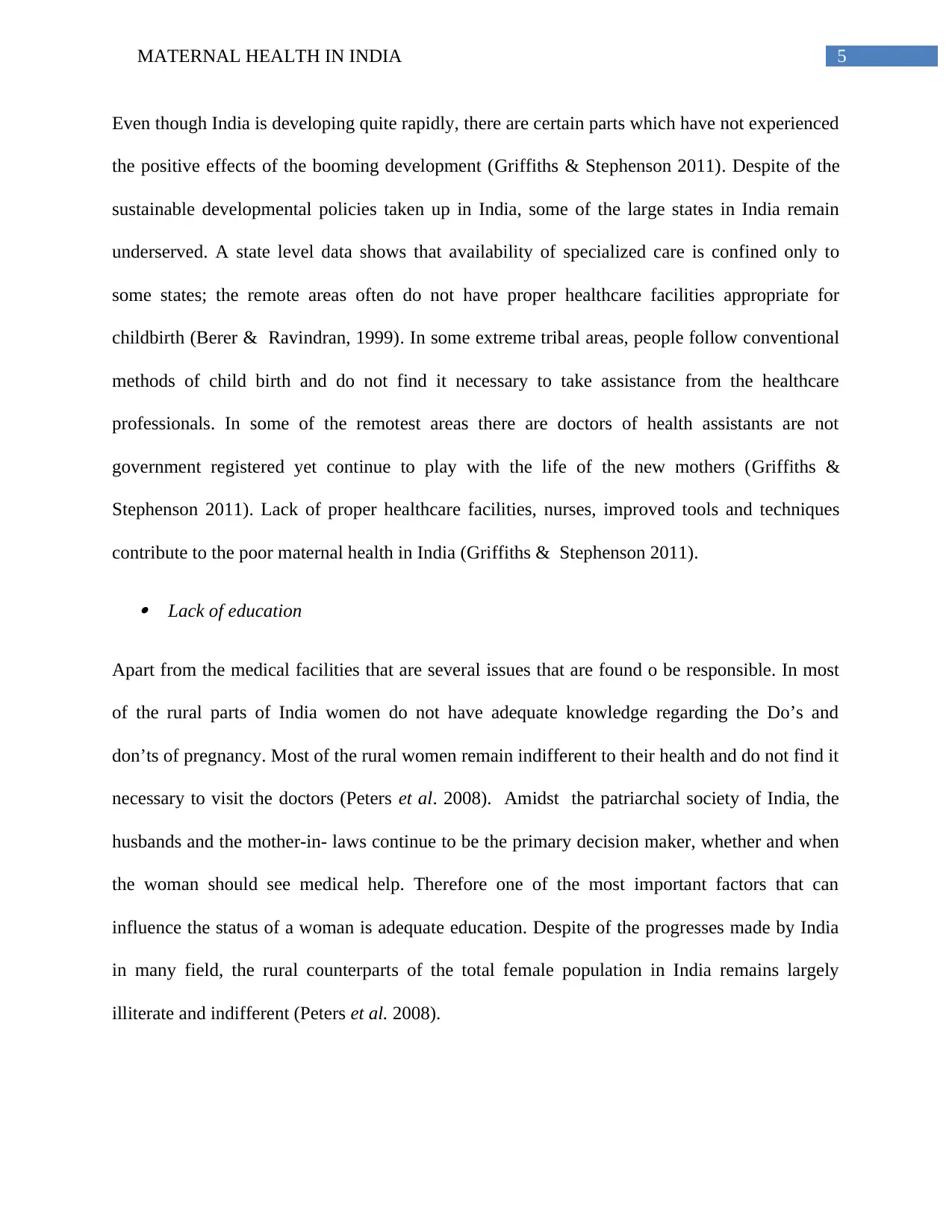
5MATERNAL HEALTH IN INDIA
Even though India is developing quite rapidly, there are certain parts which have not experienced
the positive effects of the booming development (Griffiths & Stephenson 2011). Despite of the
sustainable developmental policies taken up in India, some of the large states in India remain
underserved. A state level data shows that availability of specialized care is confined only to
some states; the remote areas often do not have proper healthcare facilities appropriate for
childbirth (Berer & Ravindran, 1999). In some extreme tribal areas, people follow conventional
methods of child birth and do not find it necessary to take assistance from the healthcare
professionals. In some of the remotest areas there are doctors of health assistants are not
government registered yet continue to play with the life of the new mothers (Griffiths &
Stephenson 2011). Lack of proper healthcare facilities, nurses, improved tools and techniques
contribute to the poor maternal health in India (Griffiths & Stephenson 2011).
Lack of education
Apart from the medical facilities that are several issues that are found o be responsible. In most
of the rural parts of India women do not have adequate knowledge regarding the Do’s and
don’ts of pregnancy. Most of the rural women remain indifferent to their health and do not find it
necessary to visit the doctors (Peters et al. 2008). Amidst the patriarchal society of India, the
husbands and the mother-in- laws continue to be the primary decision maker, whether and when
the woman should see medical help. Therefore one of the most important factors that can
influence the status of a woman is adequate education. Despite of the progresses made by India
in many field, the rural counterparts of the total female population in India remains largely
illiterate and indifferent (Peters et al. 2008).
Even though India is developing quite rapidly, there are certain parts which have not experienced
the positive effects of the booming development (Griffiths & Stephenson 2011). Despite of the
sustainable developmental policies taken up in India, some of the large states in India remain
underserved. A state level data shows that availability of specialized care is confined only to
some states; the remote areas often do not have proper healthcare facilities appropriate for
childbirth (Berer & Ravindran, 1999). In some extreme tribal areas, people follow conventional
methods of child birth and do not find it necessary to take assistance from the healthcare
professionals. In some of the remotest areas there are doctors of health assistants are not
government registered yet continue to play with the life of the new mothers (Griffiths &
Stephenson 2011). Lack of proper healthcare facilities, nurses, improved tools and techniques
contribute to the poor maternal health in India (Griffiths & Stephenson 2011).
Lack of education
Apart from the medical facilities that are several issues that are found o be responsible. In most
of the rural parts of India women do not have adequate knowledge regarding the Do’s and
don’ts of pregnancy. Most of the rural women remain indifferent to their health and do not find it
necessary to visit the doctors (Peters et al. 2008). Amidst the patriarchal society of India, the
husbands and the mother-in- laws continue to be the primary decision maker, whether and when
the woman should see medical help. Therefore one of the most important factors that can
influence the status of a woman is adequate education. Despite of the progresses made by India
in many field, the rural counterparts of the total female population in India remains largely
illiterate and indifferent (Peters et al. 2008).
⊘ This is a preview!⊘
Do you want full access?
Subscribe today to unlock all pages.

Trusted by 1+ million students worldwide
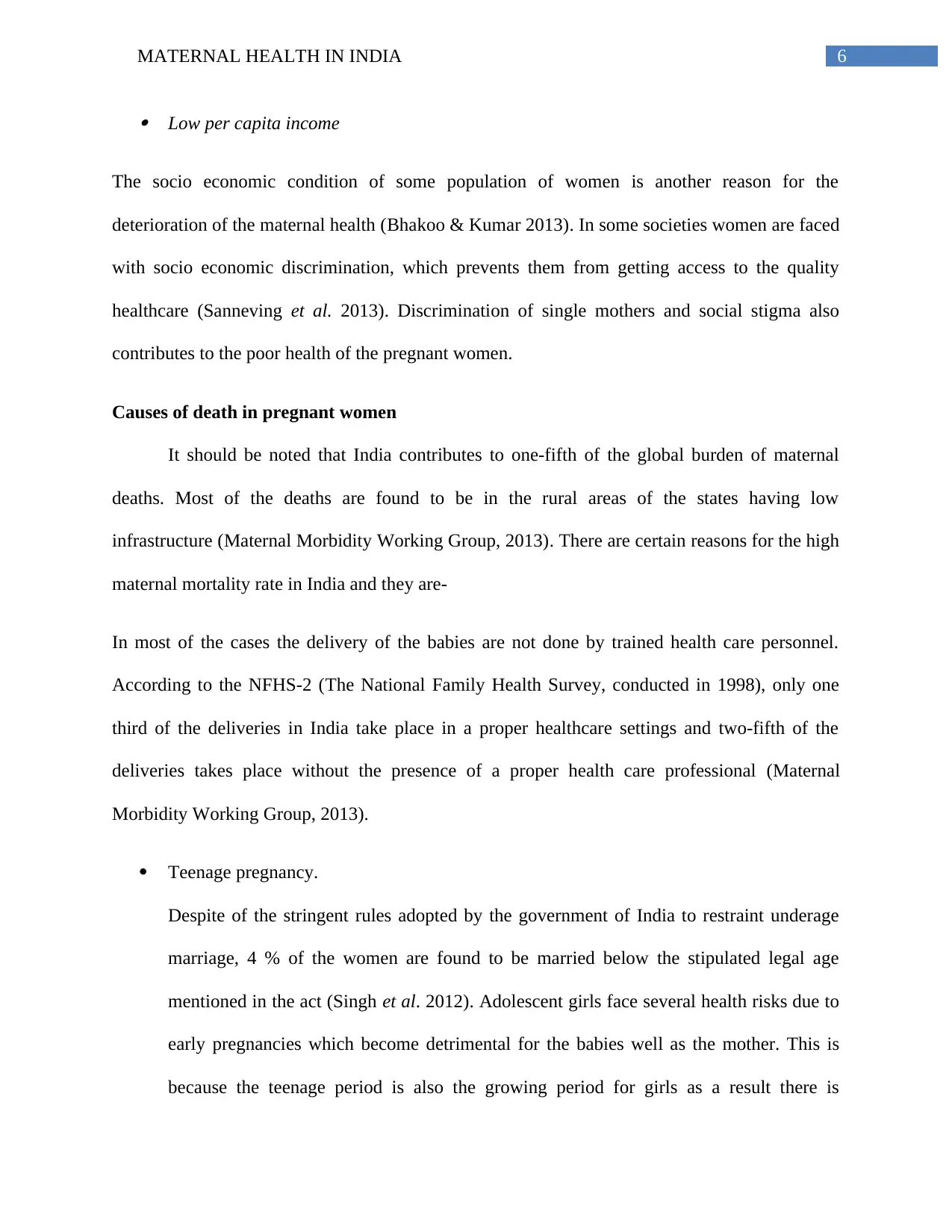
6MATERNAL HEALTH IN INDIA
Low per capita income
The socio economic condition of some population of women is another reason for the
deterioration of the maternal health (Bhakoo & Kumar 2013). In some societies women are faced
with socio economic discrimination, which prevents them from getting access to the quality
healthcare (Sanneving et al. 2013). Discrimination of single mothers and social stigma also
contributes to the poor health of the pregnant women.
Causes of death in pregnant women
It should be noted that India contributes to one-fifth of the global burden of maternal
deaths. Most of the deaths are found to be in the rural areas of the states having low
infrastructure (Maternal Morbidity Working Group, 2013). There are certain reasons for the high
maternal mortality rate in India and they are-
In most of the cases the delivery of the babies are not done by trained health care personnel.
According to the NFHS-2 (The National Family Health Survey, conducted in 1998), only one
third of the deliveries in India take place in a proper healthcare settings and two-fifth of the
deliveries takes place without the presence of a proper health care professional (Maternal
Morbidity Working Group, 2013).
Teenage pregnancy.
Despite of the stringent rules adopted by the government of India to restraint underage
marriage, 4 % of the women are found to be married below the stipulated legal age
mentioned in the act (Singh et al. 2012). Adolescent girls face several health risks due to
early pregnancies which become detrimental for the babies well as the mother. This is
because the teenage period is also the growing period for girls as a result there is
Low per capita income
The socio economic condition of some population of women is another reason for the
deterioration of the maternal health (Bhakoo & Kumar 2013). In some societies women are faced
with socio economic discrimination, which prevents them from getting access to the quality
healthcare (Sanneving et al. 2013). Discrimination of single mothers and social stigma also
contributes to the poor health of the pregnant women.
Causes of death in pregnant women
It should be noted that India contributes to one-fifth of the global burden of maternal
deaths. Most of the deaths are found to be in the rural areas of the states having low
infrastructure (Maternal Morbidity Working Group, 2013). There are certain reasons for the high
maternal mortality rate in India and they are-
In most of the cases the delivery of the babies are not done by trained health care personnel.
According to the NFHS-2 (The National Family Health Survey, conducted in 1998), only one
third of the deliveries in India take place in a proper healthcare settings and two-fifth of the
deliveries takes place without the presence of a proper health care professional (Maternal
Morbidity Working Group, 2013).
Teenage pregnancy.
Despite of the stringent rules adopted by the government of India to restraint underage
marriage, 4 % of the women are found to be married below the stipulated legal age
mentioned in the act (Singh et al. 2012). Adolescent girls face several health risks due to
early pregnancies which become detrimental for the babies well as the mother. This is
because the teenage period is also the growing period for girls as a result there is
Paraphrase This Document
Need a fresh take? Get an instant paraphrase of this document with our AI Paraphraser
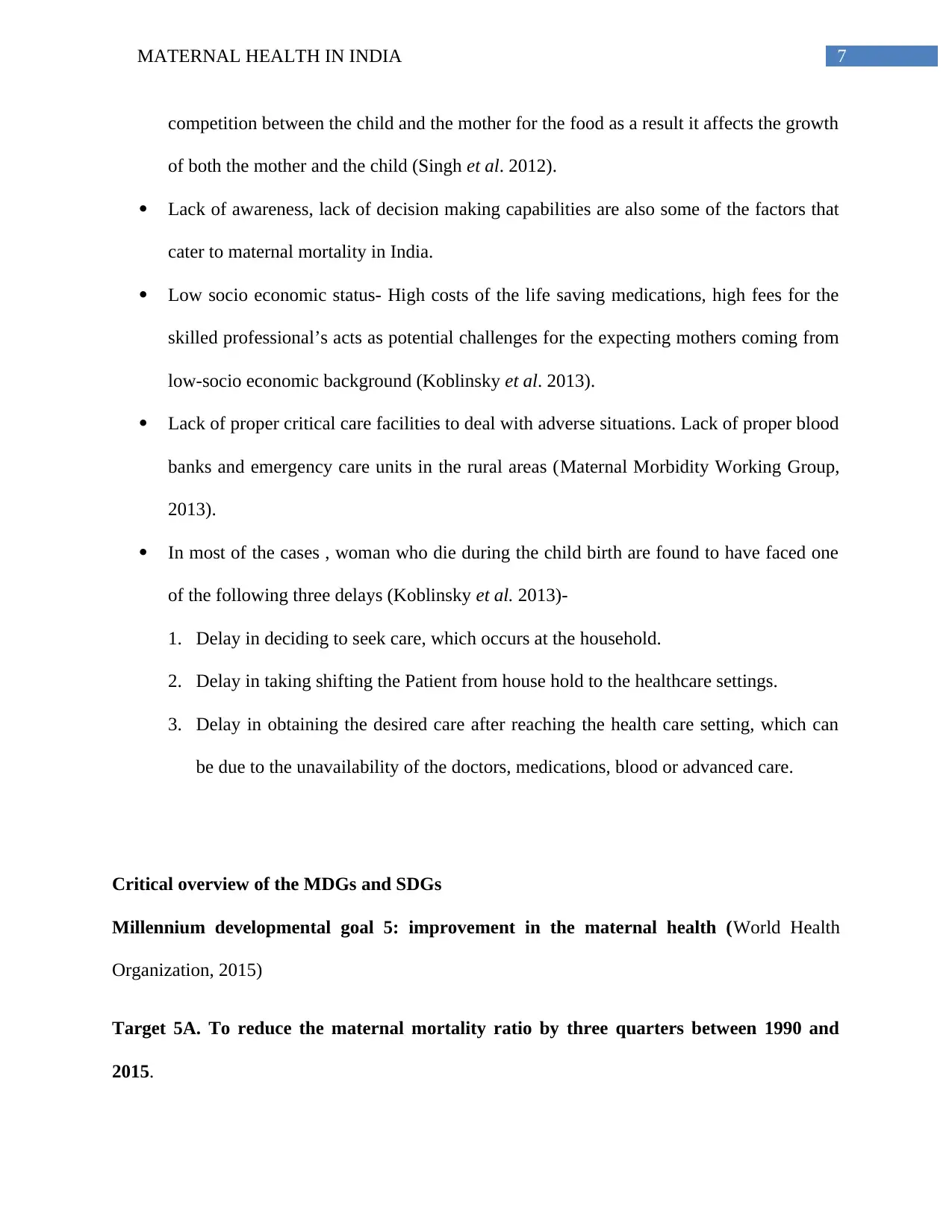
7MATERNAL HEALTH IN INDIA
competition between the child and the mother for the food as a result it affects the growth
of both the mother and the child (Singh et al. 2012).
Lack of awareness, lack of decision making capabilities are also some of the factors that
cater to maternal mortality in India.
Low socio economic status- High costs of the life saving medications, high fees for the
skilled professional’s acts as potential challenges for the expecting mothers coming from
low-socio economic background (Koblinsky et al. 2013).
Lack of proper critical care facilities to deal with adverse situations. Lack of proper blood
banks and emergency care units in the rural areas (Maternal Morbidity Working Group,
2013).
In most of the cases , woman who die during the child birth are found to have faced one
of the following three delays (Koblinsky et al. 2013)-
1. Delay in deciding to seek care, which occurs at the household.
2. Delay in taking shifting the Patient from house hold to the healthcare settings.
3. Delay in obtaining the desired care after reaching the health care setting, which can
be due to the unavailability of the doctors, medications, blood or advanced care.
Critical overview of the MDGs and SDGs
Millennium developmental goal 5: improvement in the maternal health (World Health
Organization, 2015)
Target 5A. To reduce the maternal mortality ratio by three quarters between 1990 and
2015.
competition between the child and the mother for the food as a result it affects the growth
of both the mother and the child (Singh et al. 2012).
Lack of awareness, lack of decision making capabilities are also some of the factors that
cater to maternal mortality in India.
Low socio economic status- High costs of the life saving medications, high fees for the
skilled professional’s acts as potential challenges for the expecting mothers coming from
low-socio economic background (Koblinsky et al. 2013).
Lack of proper critical care facilities to deal with adverse situations. Lack of proper blood
banks and emergency care units in the rural areas (Maternal Morbidity Working Group,
2013).
In most of the cases , woman who die during the child birth are found to have faced one
of the following three delays (Koblinsky et al. 2013)-
1. Delay in deciding to seek care, which occurs at the household.
2. Delay in taking shifting the Patient from house hold to the healthcare settings.
3. Delay in obtaining the desired care after reaching the health care setting, which can
be due to the unavailability of the doctors, medications, blood or advanced care.
Critical overview of the MDGs and SDGs
Millennium developmental goal 5: improvement in the maternal health (World Health
Organization, 2015)
Target 5A. To reduce the maternal mortality ratio by three quarters between 1990 and
2015.
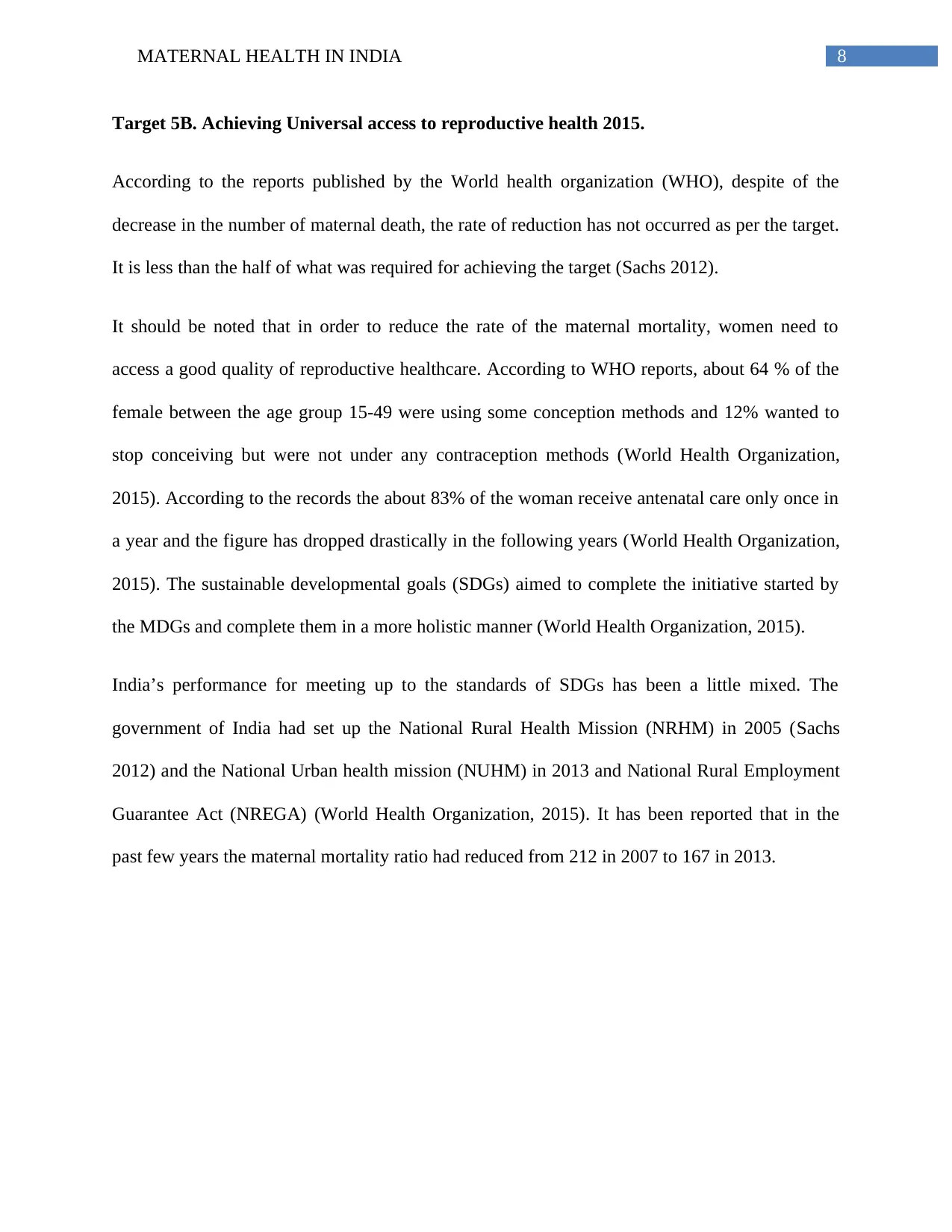
8MATERNAL HEALTH IN INDIA
Target 5B. Achieving Universal access to reproductive health 2015.
According to the reports published by the World health organization (WHO), despite of the
decrease in the number of maternal death, the rate of reduction has not occurred as per the target.
It is less than the half of what was required for achieving the target (Sachs 2012).
It should be noted that in order to reduce the rate of the maternal mortality, women need to
access a good quality of reproductive healthcare. According to WHO reports, about 64 % of the
female between the age group 15-49 were using some conception methods and 12% wanted to
stop conceiving but were not under any contraception methods (World Health Organization,
2015). According to the records the about 83% of the woman receive antenatal care only once in
a year and the figure has dropped drastically in the following years (World Health Organization,
2015). The sustainable developmental goals (SDGs) aimed to complete the initiative started by
the MDGs and complete them in a more holistic manner (World Health Organization, 2015).
India’s performance for meeting up to the standards of SDGs has been a little mixed. The
government of India had set up the National Rural Health Mission (NRHM) in 2005 (Sachs
2012) and the National Urban health mission (NUHM) in 2013 and National Rural Employment
Guarantee Act (NREGA) (World Health Organization, 2015). It has been reported that in the
past few years the maternal mortality ratio had reduced from 212 in 2007 to 167 in 2013.
Target 5B. Achieving Universal access to reproductive health 2015.
According to the reports published by the World health organization (WHO), despite of the
decrease in the number of maternal death, the rate of reduction has not occurred as per the target.
It is less than the half of what was required for achieving the target (Sachs 2012).
It should be noted that in order to reduce the rate of the maternal mortality, women need to
access a good quality of reproductive healthcare. According to WHO reports, about 64 % of the
female between the age group 15-49 were using some conception methods and 12% wanted to
stop conceiving but were not under any contraception methods (World Health Organization,
2015). According to the records the about 83% of the woman receive antenatal care only once in
a year and the figure has dropped drastically in the following years (World Health Organization,
2015). The sustainable developmental goals (SDGs) aimed to complete the initiative started by
the MDGs and complete them in a more holistic manner (World Health Organization, 2015).
India’s performance for meeting up to the standards of SDGs has been a little mixed. The
government of India had set up the National Rural Health Mission (NRHM) in 2005 (Sachs
2012) and the National Urban health mission (NUHM) in 2013 and National Rural Employment
Guarantee Act (NREGA) (World Health Organization, 2015). It has been reported that in the
past few years the maternal mortality ratio had reduced from 212 in 2007 to 167 in 2013.
⊘ This is a preview!⊘
Do you want full access?
Subscribe today to unlock all pages.

Trusted by 1+ million students worldwide
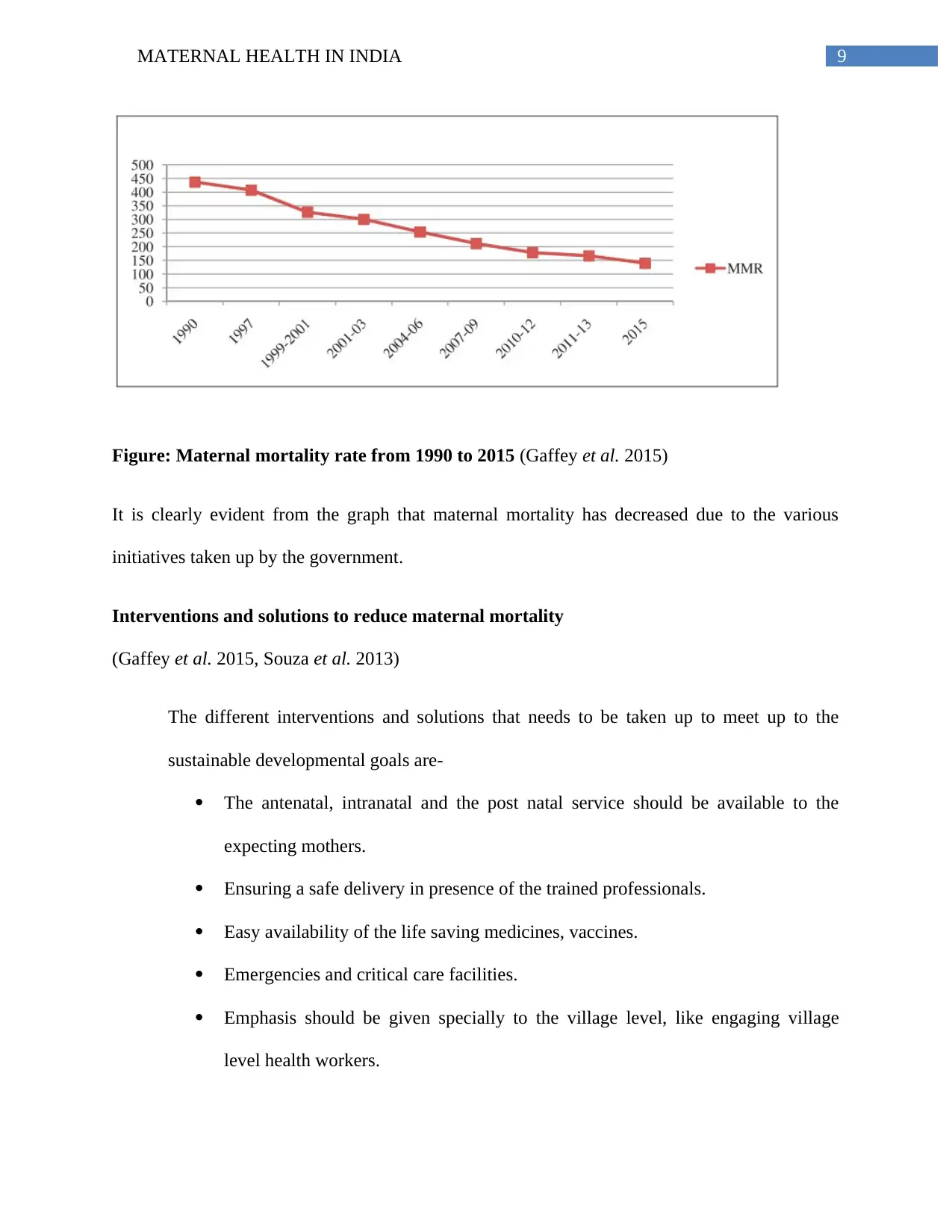
9MATERNAL HEALTH IN INDIA
Figure: Maternal mortality rate from 1990 to 2015 (Gaffey et al. 2015)
It is clearly evident from the graph that maternal mortality has decreased due to the various
initiatives taken up by the government.
Interventions and solutions to reduce maternal mortality
(Gaffey et al. 2015, Souza et al. 2013)
The different interventions and solutions that needs to be taken up to meet up to the
sustainable developmental goals are-
The antenatal, intranatal and the post natal service should be available to the
expecting mothers.
Ensuring a safe delivery in presence of the trained professionals.
Easy availability of the life saving medicines, vaccines.
Emergencies and critical care facilities.
Emphasis should be given specially to the village level, like engaging village
level health workers.
Figure: Maternal mortality rate from 1990 to 2015 (Gaffey et al. 2015)
It is clearly evident from the graph that maternal mortality has decreased due to the various
initiatives taken up by the government.
Interventions and solutions to reduce maternal mortality
(Gaffey et al. 2015, Souza et al. 2013)
The different interventions and solutions that needs to be taken up to meet up to the
sustainable developmental goals are-
The antenatal, intranatal and the post natal service should be available to the
expecting mothers.
Ensuring a safe delivery in presence of the trained professionals.
Easy availability of the life saving medicines, vaccines.
Emergencies and critical care facilities.
Emphasis should be given specially to the village level, like engaging village
level health workers.
Paraphrase This Document
Need a fresh take? Get an instant paraphrase of this document with our AI Paraphraser
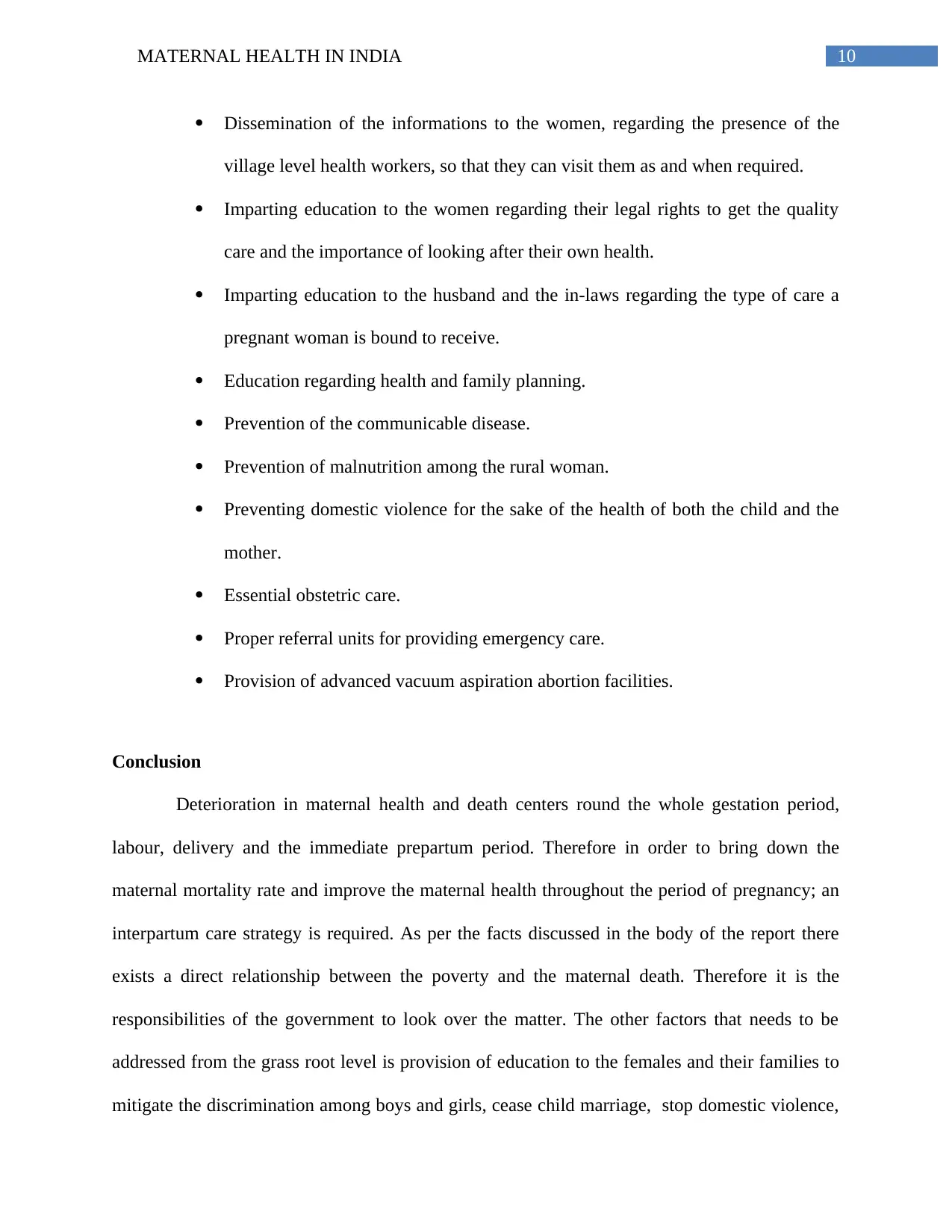
10MATERNAL HEALTH IN INDIA
Dissemination of the informations to the women, regarding the presence of the
village level health workers, so that they can visit them as and when required.
Imparting education to the women regarding their legal rights to get the quality
care and the importance of looking after their own health.
Imparting education to the husband and the in-laws regarding the type of care a
pregnant woman is bound to receive.
Education regarding health and family planning.
Prevention of the communicable disease.
Prevention of malnutrition among the rural woman.
Preventing domestic violence for the sake of the health of both the child and the
mother.
Essential obstetric care.
Proper referral units for providing emergency care.
Provision of advanced vacuum aspiration abortion facilities.
Conclusion
Deterioration in maternal health and death centers round the whole gestation period,
labour, delivery and the immediate prepartum period. Therefore in order to bring down the
maternal mortality rate and improve the maternal health throughout the period of pregnancy; an
interpartum care strategy is required. As per the facts discussed in the body of the report there
exists a direct relationship between the poverty and the maternal death. Therefore it is the
responsibilities of the government to look over the matter. The other factors that needs to be
addressed from the grass root level is provision of education to the females and their families to
mitigate the discrimination among boys and girls, cease child marriage, stop domestic violence,
Dissemination of the informations to the women, regarding the presence of the
village level health workers, so that they can visit them as and when required.
Imparting education to the women regarding their legal rights to get the quality
care and the importance of looking after their own health.
Imparting education to the husband and the in-laws regarding the type of care a
pregnant woman is bound to receive.
Education regarding health and family planning.
Prevention of the communicable disease.
Prevention of malnutrition among the rural woman.
Preventing domestic violence for the sake of the health of both the child and the
mother.
Essential obstetric care.
Proper referral units for providing emergency care.
Provision of advanced vacuum aspiration abortion facilities.
Conclusion
Deterioration in maternal health and death centers round the whole gestation period,
labour, delivery and the immediate prepartum period. Therefore in order to bring down the
maternal mortality rate and improve the maternal health throughout the period of pregnancy; an
interpartum care strategy is required. As per the facts discussed in the body of the report there
exists a direct relationship between the poverty and the maternal death. Therefore it is the
responsibilities of the government to look over the matter. The other factors that needs to be
addressed from the grass root level is provision of education to the females and their families to
mitigate the discrimination among boys and girls, cease child marriage, stop domestic violence,
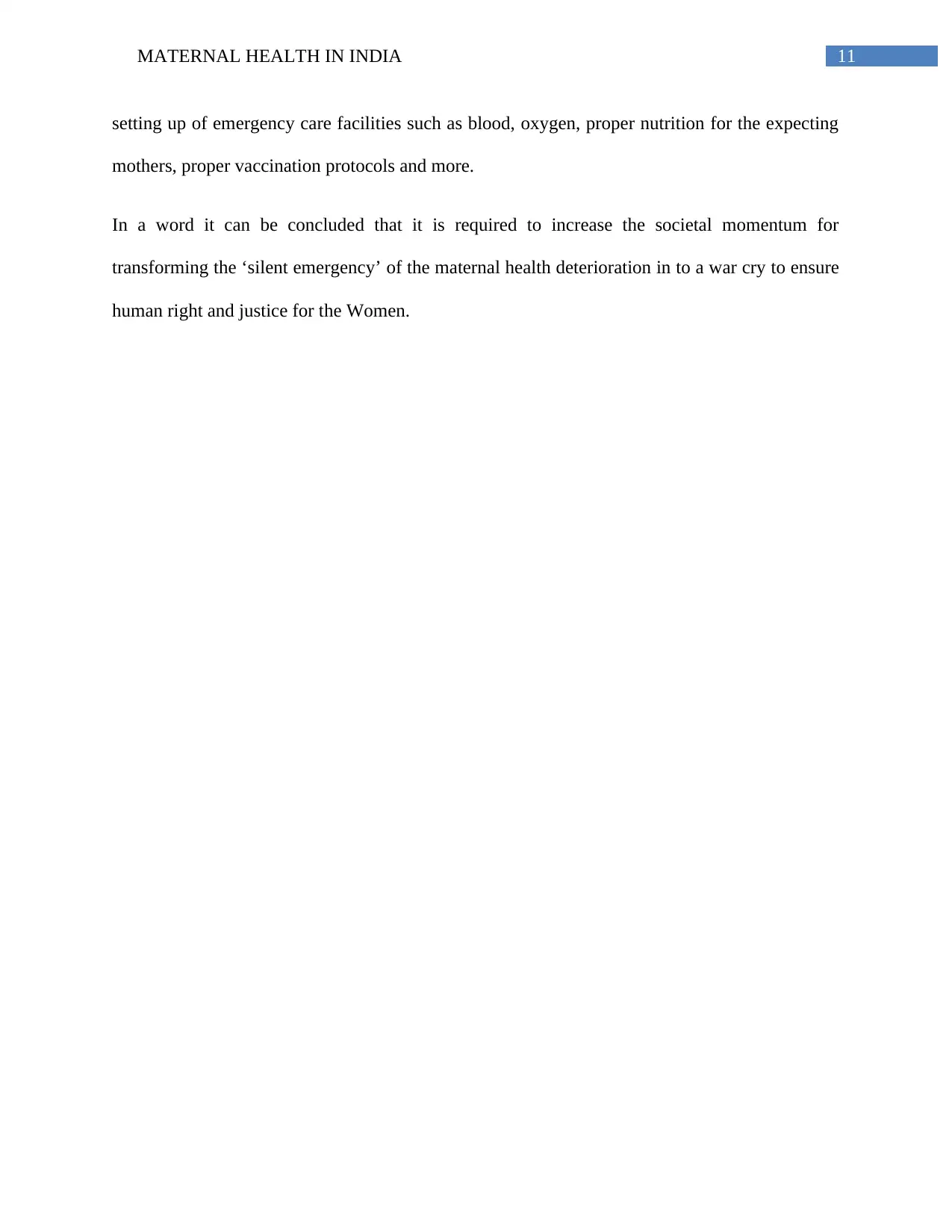
11MATERNAL HEALTH IN INDIA
setting up of emergency care facilities such as blood, oxygen, proper nutrition for the expecting
mothers, proper vaccination protocols and more.
In a word it can be concluded that it is required to increase the societal momentum for
transforming the ‘silent emergency’ of the maternal health deterioration in to a war cry to ensure
human right and justice for the Women.
setting up of emergency care facilities such as blood, oxygen, proper nutrition for the expecting
mothers, proper vaccination protocols and more.
In a word it can be concluded that it is required to increase the societal momentum for
transforming the ‘silent emergency’ of the maternal health deterioration in to a war cry to ensure
human right and justice for the Women.
⊘ This is a preview!⊘
Do you want full access?
Subscribe today to unlock all pages.

Trusted by 1+ million students worldwide
1 out of 15
Related Documents
Your All-in-One AI-Powered Toolkit for Academic Success.
+13062052269
info@desklib.com
Available 24*7 on WhatsApp / Email
![[object Object]](/_next/static/media/star-bottom.7253800d.svg)
Unlock your academic potential
Copyright © 2020–2025 A2Z Services. All Rights Reserved. Developed and managed by ZUCOL.





